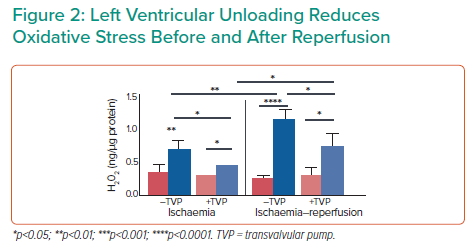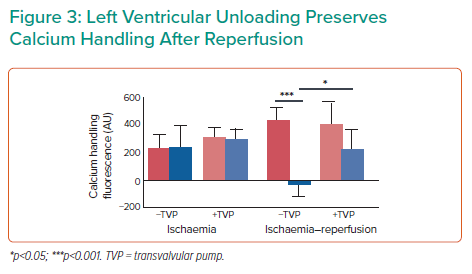The Kapur Laboratory previously demonstrated that left ventricular (LV) transvalvular unloading limits damage due to ischaemic injury during MI.1 LV unloading reduced infarct size, despite 210 minutes of occlusion without reperfusion or opening the blocked artery. Reperfusion injury still occurred with and without unloading. However, the magnitude of injury was lower in the unloaded treatment arm. These data suggest that ischaemia and reperfusion injury are distinct phenomena.
Dr Swain’s research hypothesis is that LV unloading reduces infarct size and promotes myocardial recovery by first reducing ischaemic injury, then further limiting reperfusion injury. Hypoxia characterises the ischaemic phase of a heart attack before reperfusion. Subsequent metabolic changes in myocardial cells result in increased glycolysis, lactate production, impaired calcium handling during reperfusion, mitochondrial disruption and, ultimately, apoptosis or necrosis.2
LV unloading with Impella CP improves oxygen delivery in a preclinical ischaemic model of coronary artery occlusion, as is evidenced by decreased levels of hypoxia-inducible factor-1 α and its downstream target proteins in the unloaded ventricle.1 Global metabolic analysis and the reduction of lactate and glucose levels suggest that LV unloading during ischaemia decreases glycolysis compared with ischaemia alone, reducing tissue hypoxia within the infarct zone (Figure 1).
LV unloading reduces oxidative stress before and after reperfusion, as indicated by decreased hydrogen peroxide levels (Figure 2), and also stabilises calcium handling after reperfusion (Figure 3). Taken together, these unpublished data demonstrate that LV unloading reduces ischaemic injury by mitigating tissue hypoxia.
Future studies include optimising the kinetics of ischaemic and post-ischaemic conditioning with Impella, as well as further investigation into the molecular mechanisms of ischaemic unloading and unloading post-reperfusion.
Dr Swain’s abstract presentation was awarded an Acute Cardiac Unloading and REcovery Research Grant.












